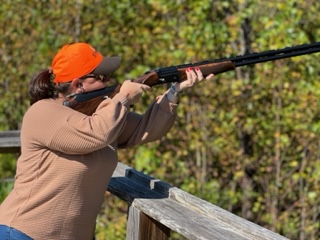BY KATE AHNSTROM
Geeeeet it!”, I holler to Gunner as he carefully picks his path into the oncoming waves. He’s not too sure about the salty sea water which is why I chose to introduce him during low tide. His favorite Dokken duck bobs along as a small white-capped wave rolls it towards him. As he pushes forward for the retrieve, I realize we don’t have much time. With the printing of this article, we will be just a month away from the start of the hunt season! Mike, Gunner and I are on family beach vacation as I write this article. Bird hunting seems forever away at this moment, but it’s not.
Summertime in the south is always tough to get motivated when planning outdoor activities but there are certainly work arounds. Start early in the morning or wait until late in the day. The sun is lower, the temps are cooler, and more daylight means more time to accomplish much needed training and tasks to prepare for the season.
Location, Location, Location
The Labor Day holiday ushers in the start of the season with doves. There is no doubt about it, dove day opener ranks right up there with that first Saturday for deer open firearms. The air is electric as you drive out to the fields. Speaking of fields, where are you headed for your hunt? We will again host at Bacon Farms in Lunenburg. The sandier soil and excellent field management by Jacob Bacon are second to none. His hunt fields are beautifully sown with wheat, milo and grass mixes, making for tremendous upland fields the following month.
The secret to a great dove hunt is to keep the ground bare. Dove are not chickens; they can’t scratch the ground to feed. They have weak legs but strong wings so they will always look for their feed readily sitting atop the ground. When you are booking your dove hunt, be sure to select a location that offers plenty of seed crop but has bare ground.
There is also a science to knowing when to mow strips in the hunt field so the birds will start coming in to feed. You never want to do it too early and you need to monitor the birds, so you know when to cut a few more strips. Most importantly, keep the ground as bare as possible. A few other great aspects to look for in a phenomenal dove hunt are roosting wires and hedgerows.
Skycarp- The Other Dark Meat
Dove might be the main driver for the beginning of the season but, there is another species we can thoroughly enjoy beginning September 1st, Canada goose. Unlike the migratory geese, these residents offer a greater bag limit, more locations to hunt and less calling skills. They also don’t require nearly as much equipment such as waders, expansive decoy spreads or expensive cold weather gear.
September goose season is excellent for anyone that is trying to break into hunting the species. The resident population will gravitate towards freshly cut small grain fields such as wheat, oats, barley even hay fields in the early morning or late afternoon hours. During the day they laze about on farm ponds, lakes in subdivisions and, of course, Walmart parking lots. Please don’t throw out your blind at Walmart, even though EVERY single one of us wishes we could.
Scouting is key for any species you’ll target this year. Since August is typically our most brutal month when it comes to heat and humidity, jump in the truck and crank the AC. As you’re driving around areas that may hold birds, take note of the locations and seek permission from the landowner. Farmers hate the damage done by geese and are usually very happy to have someone come in to mitigate but always be respectful and leave the land better than when you found it.
When you find a flock, note the feeding behavior. Are they in the center or have they already eaten of most of the dropped crop and moved to the outer edges? This will let you know if this patch is worth visiting again or if the flock is moving soon to better feeding grounds. Take note of their flight paths and how they choose to enter and exit the field. Where can you best set up your blind? Be sure it’s concealed and well! Calling should be limited, often calling isn’t necessary. Resident birds are not as vocal as migratory birds.
Whether you’re going after dove or goose in a few weeks, have your gear and your shooting ready. Be comfortable shooting from a seated position – an excellent tactic to lessen the likelihood of flaring birds. Keep your shooting skills sharp and practice those higher, passing shots. Don’t over accessorize, keeping it simple and to a few core components is always best and won’t stress you out or confuse you. Most importantly, be sure to share time on the clay course for practice or the hunt field for harvest with a friend or family. And, for those of you that always wait until the last minute, be sure to sign up for our Procrastinator’s Practice on Saturday, August 31st. Details can be found at VirginiaShootingSports.com/Events.



